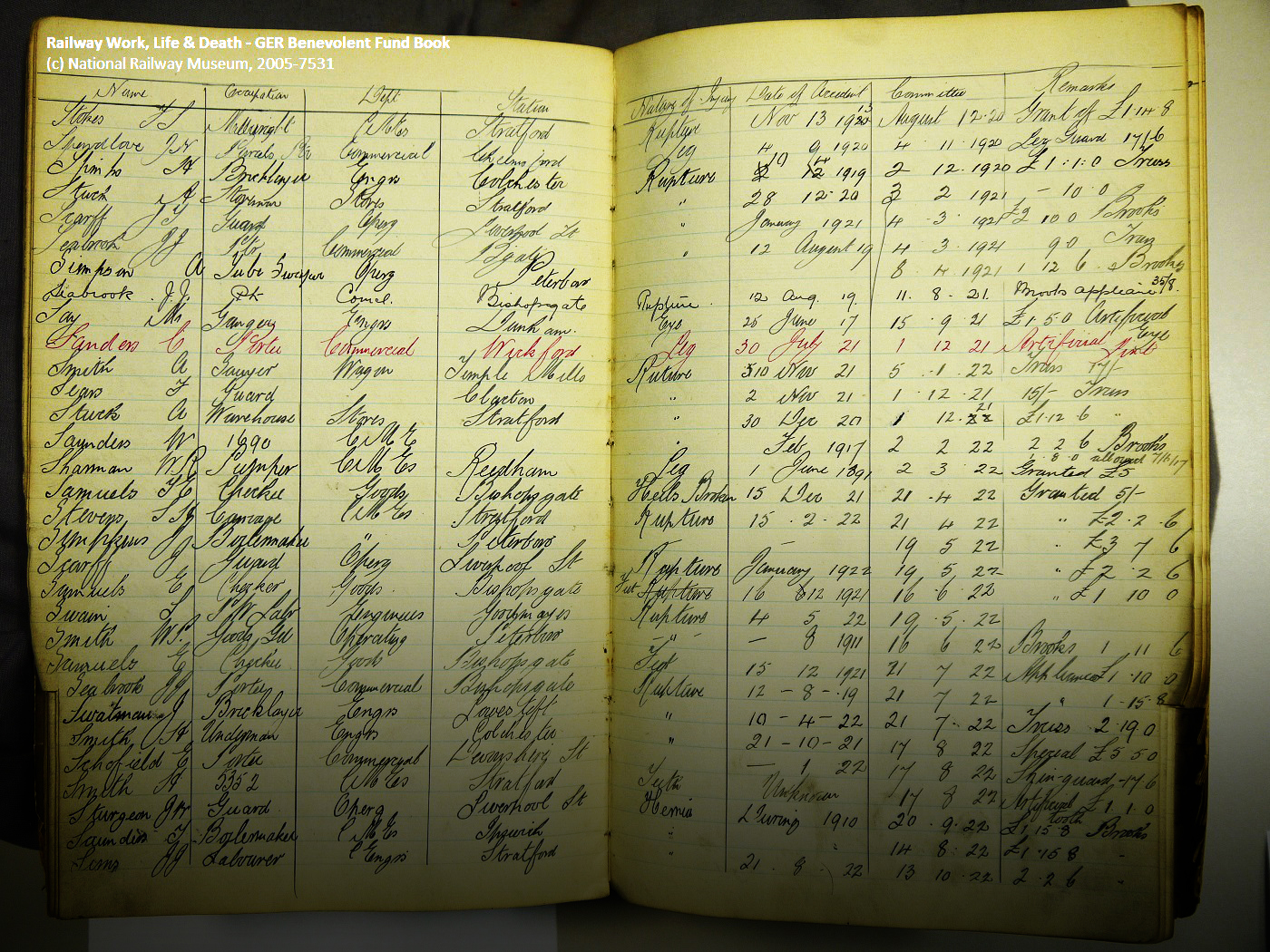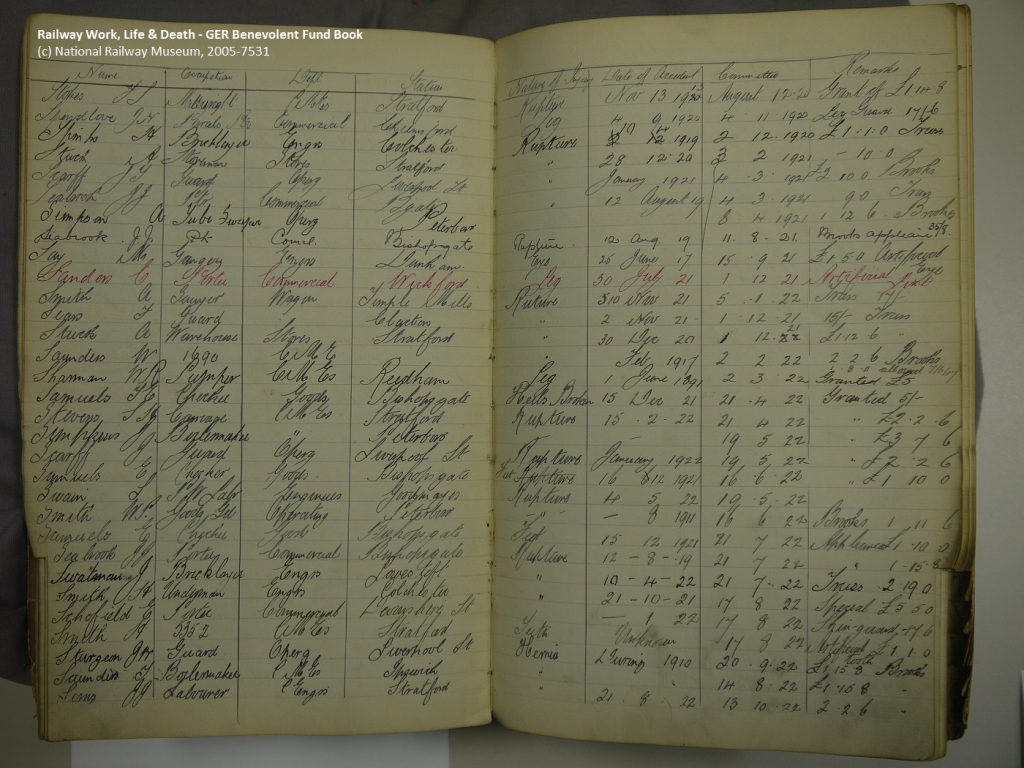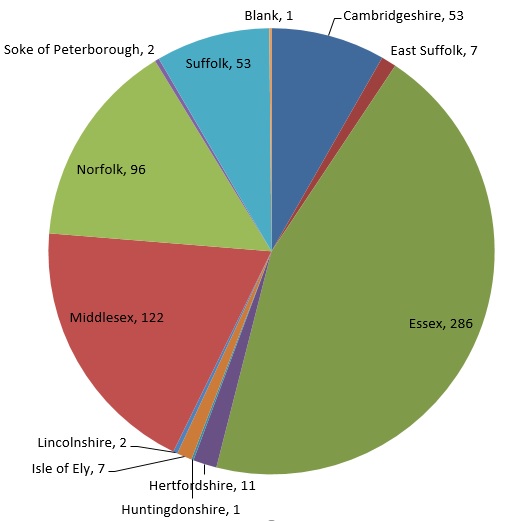On 3 December 1918, A Carter, an employee of the Great Eastern Railway, had an accident at work which resulted in a leg amputation. While we don’t have details of the accident, we do have some information about what came next. Evidently he was fitted with an artificial limb, for by June 1923 it was in need of repair. He approached the Great Eastern Railway’s Benevolent Fund for support; at the meeting of 27 June 1923 they agreed to repair his leg at the Company’s Stratford works. Presumably the Company felt some sense of obligation to Carter—and the other three men whose prosthetic legs were also to be repaired at Stratford following the meeting.
These details come from the latest set of data to be released by the ‘Railway Work, Life & Death’ project. We’re a collaboration between the National Railway Museum and the University of Portsmouth, exploring railway worker accidents in Britain and Ireland from the later 19th century to the Second World War. So far, thanks to the brilliant National Railway Museum volunteers, we’ve transcribed details of nearly 4,000 accidents that were investigated by state inspectors between 1911 and 1915—freely available through our project website.
Our new details look at what happened after the accident, helping us understand the impacts of accidents on the individuals involved. Many workers died as a result of their injuries. For those that survived, some were left with life-changing disabilities. While after the 1897 Workmen’s Compensation Act some financial provision was made for the injured, the railway companies already had benevolent societies in place—membership organisations which would contribute to costs incurred particularly through illness or accident.
The record book for the Great Eastern Railway’s Benevolent Fund, covering 1913-1923, survives in the archives at the National Railway Museum—and has now been fully transcribed as part of our project, also available through our project website. As with the first part of our project, the only way that this has been possible has been through the hard work of our enthusiastic and knowledgeable volunteers, so we owe them a great deal of thanks.
The record book gives us brief details about claimants, including in most cases the date of their accident, their occupation, department, the station at which they were based, the nature of their injury, the value of the award given and what the money was to be spent on. Previously it was all entered in the book by hand, arranged alphabetically but by the date at which the claim was made. All of this meant it wasn’t easily searchable—but now, through our database, it’s very straightforward to explore.
This is well-timed, as it’s currently Disability History Month. The new GER data shows us how railway workplace accidents produced disabilities—and plenty of them. There are something over 500 individuals listed across the 641 applications, and nearly 140 of those people were claiming for injuries to the legs or feet—often amputations requiring prosthetic limbs.
Significantly, the details in the book show many cases where the injured individuals continued to work after their acciden—no doubt through necessity, but a valuable reminder that the idea of returning to work after severe injury is not new.
With the Fund’s details now in our database, it’s possible to approach the information in all sorts of ways which would previously have been very difficult. For example, we can easily see in which counties injured workers were based when they made their claims:
The distribution reflects what we’d probably expect for the GER—a concentration in Essex and Middlesex (for its London mileage), followed by the ‘major’ East Anglian counties. There are a couple of reminders of boundary changes which introduce administrative units we might not be familiar with today: East Suffolk and the wonderfully-named Soke of Peterborough! However, there are some outliers, too—chiefly the two cases from Lincolnshire—not errors, but employees who were at work on the Great Northern and Great Eastern Joint line (at Sleaford and Lincoln, in case you were wondering!).
While the volunteers have done an excellent job, they’ve faced some challenges as a result of inconsistencies in the original. In some cases it’s clear to see when the same individual has returned for a second or even third or fourth claim for the same injury. However, sometimes there are cases which share most of the same details, but with variations which mean we can’t say for sure that they are the same.
Sometimes those variations are due to the difficulty in interpreting the original handwriting, but sometimes the person recording the details has included an error—so the accident that W Fitt suffered in 1894 was recorded as a hernia, but the application made to the Benevolent Fund Committee in June 1923 was for repairs to a leg. It seems likely that as the two cases preceding Fitt’s in the book were for hernias, the set of ‘ditto’ marks included on Fitt’s line under the heading of ‘nature of injury’ were an error made in haste and not corrected later. (Incidentally, Fitt was just one of 25 individuals claiming for accidents which took place in the 19th century.)
While most cases featured in the book are injuries, it does also record several deaths, including the largest single payout recorded—£50 (equivalent to about £2,650 today) for ‘widow’s circumstances’, paid in 1917 to the wife of Ipswich-based foreman porter N Punchard. She only featured indirectly, as a dependent, but there were also three women who appeared as wartime workers, injured and in need of some sort of assistance.
One final point about A Carter, with whom we started this blog post. By the time he applied for the repairs to his leg, he was based in Cambridge as a crossing-keeper. It’s possible this had been his role throughout his employment—but it was also a classic post-accident role. It was the sort of task given to an employee who had previously been in a more active role but had been disabled in that job. This speaks volumes to the ways in which railway work disabled staff and how railway companies then tried to find them continued employment—albeit usually at a lower rate of pay. The companies remained profit-focused, after all.
We’ve written more about the new records in this post on the project website, too—and another post about the case of William Harwood’s missing leg.
Of course, we want you to go and explore our database for yourself, so do visit our project website and see what we have to offer. We’ll be adding more records in the coming year, as our National Railway Museum volunteers are hard at work on state accident reports produced between 1921 and 1939. We’re also working with volunteers at The National Archives and the Modern Records Centre at the University of Warwick to bring in records from the railway companies and trades unions, so there’s lots more to come!




This is one of the great projects that has been implemented. Thanks to the work of thousands of people.